Bordeaux

Bordeaux

Bordeaux | |
|---|---|
Prefecture and commune | |
| Motto(s): Lilia sola regunt lunam undas castra leonem. "The fleur-de-lis alone rules over the moon, the waves, the castle, and the lion" (in French: « Les lys règnent seuls sur la lune, les ondes, la forteresse et le lion. ») [1] | |
Location of Bordeaux | |
| Coordinates:44°50′N 0°35′W [57] | |
| Country | France |
| Region | Nouvelle-Aquitaine |
| Department | Gironde |
| Arrondissement | Bordeaux |
| Canton | 5 cantons |
| Intercommunality | Bordeaux Métropole |
| Government | |
| • Mayor(2019–2020) | Nicolas Florian (LR) |
| Area 1 | 49.36 km2(19.06 sq mi) |
| • Urban (2010) | 1,172.79 km2(452.82 sq mi) |
| • Metro (2010) | 5,613.41 km2(2,167.35 sq mi) |
| Population (2016-01-01)[2] | 256,045 |
| • Rank | 9th in France |
| • Density | 5,200/km2(13,000/sq mi) |
| • Urban (January 2011) | 760,933 [3] |
| • Metro (2013) | 2,195,335[4] |
| Demonym(s) | Bordelais |
| Time zone | UTC+01:00 (CET) |
| • Summer (DST) | UTC+02:00 (CEST) |
| INSEE/Postal code | 33063 [58] / |
| Website | www.bordeaux.fr [59] |
| Official name | Bordeaux, Port of the Moon |
| Criteria | Cultural: ii, iv |
| Reference | 1256 [60] |
| Inscription | 2007 (31st Session) |
| Area | 1,731 ha |
| Buffer zone | 11,974 ha |
| 1French Land Register data, which excludes lakes, ponds, glaciers > 1 km2(0.386 sq mi or 247 acres) and river estuaries. | |
Bordeaux (French pronunciation: [bɔʁdo] (listen); Gascon Occitan: Bordèu [buɾˈðɛw]) is a port city on the Garonne in the Gironde department in Southwestern France.
The municipality (commune) of Bordeaux proper has a population of 252,040 (2016). Together with its suburbs and satellite towns, Bordeaux is the centre of the Bordeaux Métropole. With 1,195,335 in the metropolitan area, it is the sixth-largest in France, after Paris, Marseille, Lyon, Toulouse, and Lille. It is the capital of the Nouvelle-Aquitaine region, as well as the prefecture of the Gironde department. Its inhabitants are called "Bordelais" (for men) or "Bordelaises" (women). The term "Bordelais" may also refer to the city and its surrounding region.
Being at the center of a major wine-growing and wine-producing region, Bordeaux remains a prominent powerhouse and exercises significant influence on the world wine industry although no wine production is conducted within the city limits. It is home to the world's main wine fair, Vinexpo,[5] and the wine economy in the metro area takes in 14.5 billion euros each year. Bordeaux wine has been produced in the region since the 8th century. The historic part of the city is on the UNESCO World Heritage List as "an outstanding urban and architectural ensemble" of the 18th century.[6] After Paris, Bordeaux has the highest number of preserved historical buildings of any city in France.[7]
Bordeaux | |
|---|---|
Prefecture and commune | |
| Motto(s): Lilia sola regunt lunam undas castra leonem. "The fleur-de-lis alone rules over the moon, the waves, the castle, and the lion" (in French: « Les lys règnent seuls sur la lune, les ondes, la forteresse et le lion. ») [1] | |
Location of Bordeaux | |
| Coordinates:44°50′N 0°35′W [57] | |
| Country | France |
| Region | Nouvelle-Aquitaine |
| Department | Gironde |
| Arrondissement | Bordeaux |
| Canton | 5 cantons |
| Intercommunality | Bordeaux Métropole |
| Government | |
| • Mayor(2019–2020) | Nicolas Florian (LR) |
| Area 1 | 49.36 km2(19.06 sq mi) |
| • Urban (2010) | 1,172.79 km2(452.82 sq mi) |
| • Metro (2010) | 5,613.41 km2(2,167.35 sq mi) |
| Population (2016-01-01)[2] | 256,045 |
| • Rank | 9th in France |
| • Density | 5,200/km2(13,000/sq mi) |
| • Urban (January 2011) | 760,933 [3] |
| • Metro (2013) | 2,195,335[4] |
| Demonym(s) | Bordelais |
| Time zone | UTC+01:00 (CET) |
| • Summer (DST) | UTC+02:00 (CEST) |
| INSEE/Postal code | 33063 [58] / |
| Website | www.bordeaux.fr [59] |
| Official name | Bordeaux, Port of the Moon |
| Criteria | Cultural: ii, iv |
| Reference | 1256 [60] |
| Inscription | 2007 (31st Session) |
| Area | 1,731 ha |
| Buffer zone | 11,974 ha |
| 1French Land Register data, which excludes lakes, ponds, glaciers > 1 km2(0.386 sq mi or 247 acres) and river estuaries. | |
History

Coins of the Bituriges Vivisci, 5th–1st century BC, derived from the coin designs of Greeks in pre-Roman Gaul. Cabinet des Médailles.
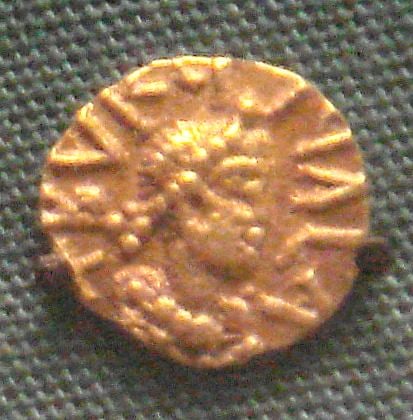
Merovingian tremisses minted in Bordeaux by the Church of Saint-Étienne, late 6th century. British Museum.
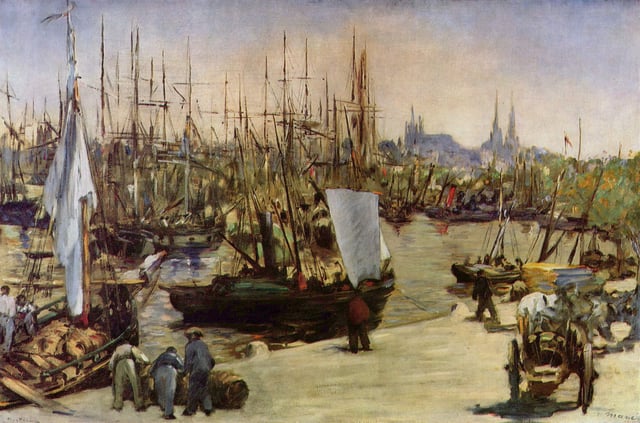
Édouard Manet: Harbour at Bordeaux, 1871

Rue Sainte-Catherine in 1905
Around 567 BC the region was the settlement of a Celtic tribe, the Bituriges Vivisci, who named the town Burdigala, probably of Aquitanian origin.
In 107 BC the Battle of Burdigala was fought by the Romans who were defending the Allobroges, a Gallic tribe allied to Rome, and the Tigurini led by Divico. The Romans were defeated and their commander, the consul Lucius Cassius Longinus, was killed in battle.
The city came under Roman rule around 60 BC, and it became an important commercial centre for tin and lead. It continued to flourish, especially during the Severan dynasty (3rd century), and acquired the status of capital of Roman Aquitaine. In 276 it was sacked by the Vandals. The Vandals attacked again in 409, followed by the Visigoths in 414, and the Franks in 498, and afterwards the city fell into a period of relative obscurity.
In the late 6th century the city re-emerged as the seat of a county and an archdiocese within the Merovingian kingdom of the Franks, but royal Frankish power was never strong. The city started to play a regional role as a major urban center on the fringes of the newly founded Frankish Duchy of Vasconia. Around 585 Gallactorius was made count of Bordeaux and fought the Basques.
In 732 the city was plundered by the troops of Abd er Rahman who stormed the fortifications and overwhelmed the Aquitanian garrison. Duke Eudes mustered a force to engage the Umayyads, eventually engaging them in the Battle of the River Garonne somewhere near the river Dordogne. The battle had a high death toll, and although Eudes was defeated he had enough troops to engage in the Battle of Poitiers and so retain his grip on Aquitaine.
In 735 following his father Eudes's death, the Aquitanian duke Hunald led a rebellion to which Charles responded by launching an expedition that captured Bordeaux. However, it was not retained for long, during the following year the Frankish commander clashed in battle with the Aquitanians but then left to take on hostile Burgundian authorities and magnates. In 745 Aquitaine faced another expedition where Charles's sons Pepin and Carloman challenged Hunald's power and defeated him. Hunald's son Waifer replaced him and confirmed Bordeaux as the capital city (along with Bourges in the north).
During the last stage of the war against Aquitaine (760–768), it was one of Waifer's last important strongholds to fall to the troops of King Pepin the Short. Charlemagne built the fortress of Fronsac (Frontiacus, Franciacus) near Bordeaux on a hill across the border with the Basques (Wascones), where Basque commanders came and pledged their loyalty (769).
In 778 Seguin (or Sihimin) was appointed count of Bordeaux, probably undermining the power of the Duke Lupo, and possibly leading to the Battle of Roncevaux Pass. In 814 Seguin was made Duke of Vasconia, but was deposed in 816 for failing to suppress a Basque rebellion. Under the Carolingians, sometimes the Counts of Bordeaux held the title concomitantly with that of Duke of Vasconia. They were to keep the Basques in check and defend the mouth of the Garonne from the Vikings when they appeared in c. 844. In Autumn 845 the Vikings were raiding Bordeaux and Saintes, count Seguin II marched on them but was captured and executed.
From the 12th to the 15th century Bordeaux regained importance following the marriage of Duchess Eléonore of Aquitaine to the French-speaking Count Henri Plantagenet, born in Le Mans, who within months of their wedding became King Henry II of England. The city flourished, primarily due to the wine trade, and the cathedral of St. André was built. It was also the capital of an independent state under Edward, the Black Prince (1362–1372), but after the Battle of Castillon (1453) it was annexed by France, and so extended its territory. The Château Trompette (Trumpet Castle) and the Fort du Hâ, built by Charles VII of France, were potent symbols of the new regime, which halted the wine commerce with England and so deprived the city of its wealth.
In 1462 Bordeaux created a local parliament. However, it only regained its importance during the 16th century when it became a major trading centre for sugar and slaves from the West Indies, along with its traditional wine exports.[8]
Bordeaux adhered to the Fronde, being effectively annexed to the Kingdom of France only in 1653, when the army of Louis XIV entered the city.
The 18th century saw the golden age of Bordeaux. Many downtown buildings (about 5,000), including those on the quays, are from this period. Victor Hugo found the town so beautiful he said: "Take Versailles, add Antwerp, and you have Bordeaux". Baron Haussmann, a long-time prefect of Bordeaux, used Bordeaux's 18th-century large-scale rebuilding as a model when he was asked by Emperor Napoleon III to transform a then still quasi-medieval Paris into a "modern" capital that would make France proud.
Towards the end of the Peninsula war on 12 March 1814, the Duke of Wellington sent William Beresford with two divisions and seized Bordeaux encountering little resistance. Bordeaux was largely anti-Bonapartist and the majority supported the Bourbons, so the British troops were treated as liberators.
In 1870, at the beginning of the Franco-Prussian war against Prussia, the French government temporarily relocated to Bordeaux from Paris. This recurred during the First World War and again very briefly during the Second World War, when it became clear that Paris would fall into German hands. However, on the last of these occasions the French capital was soon moved again to Vichy. In May and June 1940, Bordeaux was the site of the life-saving actions of the Portuguese consul-general, Aristides de Sousa Mendes, who illegally granted thousands of Portuguese visas, which were needed to pass the Spanish border, to refugees fleeing the German Occupation.
From 1940 to 1943, the Italian Royal Navy (Regia Marina Italiana) established BETASOM, a submarine base at Bordeaux. Italian submarines participated in the Battle of the Atlantic from this base, which was also a major base for German U-boats as headquarters of 12th U-boat Flotilla. The massive, reinforced concrete U-boat pens have proved impractical to demolish and are now partly used as a cultural center for exhibitions.
Geography
Bordeaux is located close to the European Atlantic coast, in the southwest of France and in the north of the Aquitaine region. It is around 500 km (310 mi) southwest of Paris. The city is built on a bend of the river Garonne, and is divided into two parts: the right bank to the east and left bank in the west. Historically the left bank is more developed because when flowing outside the bend, the water makes a furrow of the required depth to allow the passing of merchant ships, which used to offload on this side of the river. But, today, the right bank is developing, including new urban projects. In Bordeaux, the Garonne River is accessible to ocean liners. The right bank of the Garonne is a low-lying, often marshy plain.
Climate
Bordeaux's climate is classified as a temperate oceanic climate (Köppen climate classification Cfb), or in the Trewartha climate classification system as temperate oceanic or Do climate. Although summers are too cool, Bordeaux however, lies close to the humid subtropical climate zone.
Winters are cool because of the prevalence of westerly winds from the Atlantic. Summers are mild to warm and long due to the influence from the Bay of Biscay (surface temperature reaches 21 to 22 °C (70 to 72 °F)). The average seasonal winter temperature is 7.1 °C (44.8 °F), but recent winters have been warmer than this. Frosts in the winter are commonplace, occurring several times during a winter, but snowfall is very rare, occurring only once every three years. The average summer seasonal temperature is 20.7 °C (69.3 °F). The summer of 2003 set a record with an average temperature of 23.3 °C (73.9 °F).[9]
| Climate data for Bordeaux (BOD), elevation: 47 m (154 ft), 1981–2010 normals, extremes 1920–present | |||||||||||||
|---|---|---|---|---|---|---|---|---|---|---|---|---|---|
| Month | Jan | Feb | Mar | Apr | May | Jun | Jul | Aug | Sep | Oct | Nov | Dec | Year |
| Record high °C (°F) | 20.2 (68.4) | 26.2 (79.2) | 27.7 (81.9) | 31.1 (88.0) | 35.4 (95.7) | 39.2 (102.6) | 41.2 (106.2) | 40.7 (105.3) | 37.0 (98.6) | 32.2 (90.0) | 26.7 (80.1) | 22.5 (72.5) | 41.2 (106.2) |
| Average high °C (°F) | 10.1 (50.2) | 11.7 (53.1) | 15.1 (59.2) | 17.3 (63.1) | 21.2 (70.2) | 24.5 (76.1) | 26.9 (80.4) | 27.1 (80.8) | 24.0 (75.2) | 19.4 (66.9) | 13.7 (56.7) | 10.5 (50.9) | 18.5 (65.3) |
| Daily mean °C (°F) | 6.6 (43.9) | 7.5 (45.5) | 10.2 (50.4) | 12.3 (54.1) | 16.1 (61.0) | 19.3 (66.7) | 21.3 (70.3) | 21.4 (70.5) | 18.5 (65.3) | 14.9 (58.8) | 9.9 (49.8) | 7.2 (45.0) | 13.8 (56.8) |
| Average low °C (°F) | 3.1 (37.6) | 3.3 (37.9) | 5.4 (41.7) | 7.4 (45.3) | 11.0 (51.8) | 14.1 (57.4) | 15.8 (60.4) | 15.7 (60.3) | 12.9 (55.2) | 10.4 (50.7) | 6.1 (43.0) | 3.8 (38.8) | 9.1 (48.4) |
| Record low °C (°F) | −16.4 (2.5) | −14.8 (5.4) | −9.9 (14.2) | −5.3 (22.5) | −1.8 (28.8) | 2.5 (36.5) | 5.2 (41.4) | 4.7 (40.5) | −1.8 (28.8) | −5.3 (22.5) | −7.3 (18.9) | −13.4 (7.9) | −16.4 (2.5) |
| Average precipitation mm (inches) | 87.3 (3.44) | 71.7 (2.82) | 65.3 (2.57) | 78.2 (3.08) | 80.0 (3.15) | 62.2 (2.45) | 49.9 (1.96) | 56.0 (2.20) | 84.3 (3.32) | 93.3 (3.67) | 110.2 (4.34) | 105.7 (4.16) | 944.1 (37.17) |
| Average precipitation days(≥ 1.0 mm) | 12.2 | 10.1 | 11.0 | 11.9 | 10.9 | 8.3 | 7.1 | 7.5 | 9.2 | 11.0 | 12.6 | 12.4 | 124.3 |
| Average snowy days | 2.1 | 2.6 | 1.5 | 0.6 | 0.0 | 0.0 | 0.0 | 0.0 | 0.0 | 0.0 | 0.7 | 1.7 | 9.2 |
| Average relative humidity (%) | 87 | 83 | 79 | 76 | 77 | 75 | 75 | 76 | 80 | 85 | 87 | 87 | 81 |
| Mean monthly sunshine hours | 96.0 | 114.9 | 169.7 | 182.1 | 217.4 | 238.7 | 248.5 | 242.3 | 202.7 | 147.2 | 94.4 | 81.8 | 2,035.4 |
| Source: Meteo France[10][11] | |||||||||||||
| Climate data for Bordeaux (Bordeaux–Mérignac Airport), elevation: 47 m or 154 ft, 1961-1990 normals and extremes | |||||||||||||
|---|---|---|---|---|---|---|---|---|---|---|---|---|---|
| Month | Jan | Feb | Mar | Apr | May | Jun | Jul | Aug | Sep | Oct | Nov | Dec | Year |
| Record high °C (°F) | 19.1 (66.4) | 25.0 (77.0) | 27.7 (81.9) | 28.6 (83.5) | 32.6 (90.7) | 37.0 (98.6) | 38.8 (101.8) | 38.3 (100.9) | 37.0 (98.6) | 31.5 (88.7) | 24.7 (76.5) | 22.5 (72.5) | 38.8 (101.8) |
| Mean maximum °C (°F) | 12.6 (54.7) | 16.3 (61.3) | 17.1 (62.8) | 19.5 (67.1) | 25.3 (77.5) | 29.3 (84.7) | 29.2 (84.6) | 29.4 (84.9) | 27.0 (80.6) | 21.4 (70.5) | 16.1 (61.0) | 14.4 (57.9) | 29.4 (84.9) |
| Average high °C (°F) | 9.9 (49.8) | 11.1 (52.0) | 13.4 (56.1) | 16.1 (61.0) | 19.4 (66.9) | 23.2 (73.8) | 25.9 (78.6) | 25.5 (77.9) | 24.0 (75.2) | 19.3 (66.7) | 13.2 (55.8) | 10.0 (50.0) | 17.6 (63.7) |
| Daily mean °C (°F) | 6.2 (43.2) | 7.5 (45.5) | 8.7 (47.7) | 11.2 (52.2) | 14.2 (57.6) | 17.7 (63.9) | 20.2 (68.4) | 19.6 (67.3) | 17.9 (64.2) | 14.3 (57.7) | 9.1 (48.4) | 6.6 (43.9) | 12.8 (55.0) |
| Average low °C (°F) | 2.5 (36.5) | 3.6 (38.5) | 4.2 (39.6) | 6.3 (43.3) | 9.1 (48.4) | 12.4 (54.3) | 14.3 (57.7) | 13.9 (57.0) | 12.2 (54.0) | 9.2 (48.6) | 4.7 (40.5) | 3.2 (37.8) | 8.0 (46.3) |
| Mean minimum °C (°F) | −3.1 (26.4) | −1.8 (28.8) | −0.1 (31.8) | 3.7 (38.7) | 7.8 (46.0) | 9.4 (48.9) | 12.4 (54.3) | 12.6 (54.7) | 9.2 (48.6) | 5.3 (41.5) | 2.0 (35.6) | −0.4 (31.3) | −3.1 (26.4) |
| Record low °C (°F) | −16.4 (2.5) | −13.2 (8.2) | −9.9 (14.2) | −3.0 (26.6) | −0.5 (31.1) | 4.0 (39.2) | 6.9 (44.4) | 6.0 (42.8) | 2.2 (36.0) | −1.7 (28.9) | −7.3 (18.9) | −13.0 (8.6) | −16.4 (2.5) |
| Average precipitation mm (inches) | 92.4 (3.64) | 86.9 (3.42) | 74.0 (2.91) | 69.4 (2.73) | 67.4 (2.65) | 51.3 (2.02) | 41.2 (1.62) | 45.3 (1.78) | 72.0 (2.83) | 67.8 (2.67) | 96.7 (3.81) | 79.7 (3.14) | 844.1 (33.22) |
| Average precipitation days(≥ 1.0 mm) | 13.1 | 11.5 | 11.7 | 11.2 | 11.1 | 8.5 | 6.7 | 8.3 | 9.0 | 10.1 | 11.9 | 12.3 | 125.4 |
| Average snowy days | 1.1 | 1.2 | 0.6 | 0.0 | 0.0 | 0.0 | 0.0 | 0.0 | 0.0 | 0.0 | 0.2 | 0.8 | 3.9 |
| Average relative humidity (%) | 88 | 84 | 78 | 76 | 77 | 76 | 75 | 76 | 79 | 85 | 87 | 88 | 80.8 |
| Mean monthly sunshine hours | 86.3 | 108.8 | 161.9 | 189.6 | 211.1 | 242.2 | 276.3 | 248.7 | 207.1 | 165.4 | 103.2 | 83.0 | 2,083.6 |
| Percent possible sunshine | 31 | 38 | 45 | 47 | 47 | 53 | 59 | 58 | 56 | 49 | 36 | 31 | 46 |
| Source #1: NOAA[12] | |||||||||||||
| Source #2: Infoclimat.fr (humidity)[13] | |||||||||||||
Economy
Bordeaux is a major centre for business in France as it has the sixth largest metropolitan population in France. It serves as a major regional center for trade, administration, services and industry.
As of 2014, the GDP of Bordeaux is €32.7 Billion.
Wine
The vine was introduced to the Bordeaux region by the Romans, probably in the mid-first century, to provide wine for local consumption, and wine production has been continuous in the region since.[14]
Bordeaux wine growing area has about 116,160 hectares (287,000 acres) of vineyards, 57 appellations, 10,000 wine-producing estates (châteaux) and 13,000 grape growers. With an annual production of approximately 960 million bottles,[15] the Bordeaux area produces large quantities of everyday wine as well as some of the most expensive wines in the world. Included among the latter are the area's five premier cru (first growth) red wines (four from Médoc and one, Château Haut-Brion, from Graves), established by the Bordeaux Wine Official Classification of 1855:
Both red and white wines are made in the Bordeaux region. Red Bordeaux wine is called claret in the United Kingdom. Red wines are generally made from a blend of grapes, and may be made from Cabernet Sauvignon, Merlot, Cabernet Franc, Petit verdot, Malbec, and, less commonly in recent years, Carménère.
White Bordeaux is made from Sauvignon blanc, Sémillon, and Muscadelle. Sauternes is a sub-region of Graves known for its intensely sweet, white, dessert wines such as Château d'Yquem.
Because of a wine glut (wine lake) in the generic production, the price squeeze induced by an increasingly strong international competition, and vine pull schemes, the number of growers has recently dropped from 14,000 and the area under vine has also decreased significantly. In the meantime, the global demand for first growths and the most famous labels markedly increased and their prices skyrocketed.
Others
The Laser Mégajoule will be one of the most powerful lasers in the world, allowing fundamental research and the development of the laser and plasma technologies. This project, carried by the French Ministry of Defence, involves an investment of 2 billion euros. The "Road of the lasers", a major project of regional planning, promotes regional investment in optical and laser related industries leading to the Bordeaux area having the most important concentration of optical and laser expertise in Europe.
Some 20,000 people work for the aeronautic industry in Bordeaux. The city has some of the biggest companies including Dassault, EADS Sogerma, Snecma, Thales, SNPE, and others. The Dassault Falcon private jets are built there as well as the military aircraft Rafale and Mirage 2000, the Airbus A380 cockpit, the boosters of Ariane 5, and the M51 SLBM missile.
Tourism, especially wine tourism, is a major industry. Globelink.co.uk mentioned Bordeaux as the best tourist destination in Europe in 2015.[17]
Access to the port from the Atlantic is via the Gironde estuary. Almost nine million tonnes of goods arrive and leave each year.
Major companies
This list includes indigenous Bordeaux-based companies and companies that have major presence in Bordeaux, but are not necessarily headquartered there.
Arena
Cdiscount
Dassault
Marie Brizard
McKesson Corporation
Oxbow
Ricard
Sanofi Aventis
Smurfit Kappa
SNECMA
Solectron
Thales Group
Population
At the January 2011 census, there were 239,399 inhabitants in the city proper (commune) of Bordeaux. Bordeaux in its hey day had a population of 262,662 in 1968.[18] The majority of the population is French, but there are sizable groups of Italians, Spaniards (Up to 20% of the Bordeaux population claim some degree of Spanish heritage), Portuguese, Turks, Germans. https://www.citypopulation.de/php/france-gironde.php?cityid=33063 [61] .
The built-up area has grown for more than a century beyond the municipal borders of Bordeaux due to urban sprawl, so that by the January 2011 census there were 1,140,668 people living in the overall metropolitan area of Bordeaux,[4] only a fifth of whom lived in the city proper.
| 1793 | 1800 | 1806 | 1821 | 1831 | 1836 | 1841 | 1846 | 1851 |
|---|---|---|---|---|---|---|---|---|
| 104,676 | 91,652 | 92,219 | 89,202 | 99,062 | 98,705 | 104,686 | 125,520 | 130,927 |
| 1856 | 1861 | 1866 | 1872 | 1876 | 1881 | 1886 | 1891 | 1896 |
| 149,928 | 162,750 | 194,241 | 194,055 | 215,140 | 221,305 | 240,582 | 252,415 | 256,906 |
| 1901 | 1906 | 1911 | 1921 | 1926 | 1931 | 1936 | 1946 | 1954 |
| 256,638 | 251,947 | 261,678 | 267,409 | 256,026 | 262,990 | 258,348 | 253,751 | 257,946 |
| 1962 | 1968 | 1975 | 1982 | 1990 | 1999 | 2006 | 2011 | |
| 249,688 | 266,662 | 223,131 | 208,159 | 210,336 | 215,363 | 232,260 | 239,399 |
Largest communities of foreigners :
Politics
At the 2007 presidential election, the Bordelais gave 31.37% of their votes to Ségolène Royal of the Socialist Party against 30.84% to Nicolas Sarkozy, president of the UMP. Then came Francois Bayrou with 22.01%, followed by Jean-Marie Le Pen who recorded 5.42%. None of the other candidates exceeded the 5% mark. Nationally, Nicolas Sarkozy led with 31.18%, then Ségolène Royal with 25.87%, followed by François Bayrou with 18.57%. After these came Jean-Marie Le Pen with 10.44%, none of the other candidates exceeded the 5% mark. In the second round, the city of Bordeaux gave Ségolène Royal 52.44% against 47.56% for Nicolas Sarkozy, the latter being elected President of the Republic with 53.06% against 46.94% for Ségolène Royal. The abstention rates for Bordeaux were 14.52% in the first round and 15.90% in the second round. This is an earthquake in Bordeaux, a city deeply rooted right traditions.
In the parliamentary elections of 2007, the left won eight constituencies against only three for the right. It should be added that after the partial 2008 elections, the eighth district of Gironde switched to the left, bringing the count to nine. In Bordeaux, the left was for the first time in its history the majority as it held two of three constituencies following the elections. In the first division of the Gironde, the outgoing UMP MP Chantal Bourragué was well ahead with 44.81% against 25.39% for the Socialist candidate Beatrice Desaigues. In the second round, it was Chantal Bourragué who was re-elected with 54.45% against 45.55% for his socialist opponent. In the second district of Gironde the UMP mayor and all new Minister of Ecology, Energy, Sustainable Development and the Sea Alain Juppé confronted the General Counsel PS Michèle Delaunay. In the first round, Alain Juppé was well ahead with 43.73% against 31.36% for Michèle Delaunay. In the second round, it was finally Michèle Delaunay who won the election with 50.93% of the votes against 49.07% for Alain Juppé, the margin being only 670 votes. The defeat of the so-called constituency "Mayor" showed that Bordeaux was rocking increasingly left. Finally, in the third constituency of the Gironde, Noël Mamère was well ahead with 39.82% against 28.42% for the UMP candidate Elizabeth Vine. In the second round, Noël Mamère was re-elected with 62.82% against 37.18% for his right-wing rival.
In 2008 municipal elections saw the clash between mayor of Bordeaux, Alain Juppé and the President of the Regional Council of Aquitaine Socialist Alain Rousset. The PS had put up a Socialist heavyweight in the Gironde and had put great hopes in this election after the victory of Ségolène Royal and Michèle Delaunay in 2007. However, after a rather exciting campaign it was Alain Juppé who was widely elected in the first round with 56.62%, far ahead of Alain Rousset who has managed to get 34.14%. At present, of the eight cantons that has Bordeaux, five are held by the PS and three by the UMP, the left eating a little each time into the right's numbers.
In the European elections of 2009, Bordeaux voters largely voted for the UMP candidate Dominique Baudis, who won 31.54% against 15.00% for PS candidate Kader Arif. The candidate of Europe Ecology José Bové came second with 22.34%. None of the other candidates reached the 10% mark. The 2009 European elections were like the previous ones in eight constituencies. Bordeaux is located in the district "Southwest", here are the results:
UMP candidate Dominique Baudis: 26.89%. His party gained four seats. PS candidate Kader Arif: 17.79%, gaining two seats in the European Parliament. Europe Ecology candidate Bove: 15.83%, obtaining two seats. MoDem candidate Robert Rochefort: 8.61%, winning a seat. Left Front candidate Jean-Luc Mélenchon: 8.16%, gaining the last seat. At regional elections in 2010, the Socialist incumbent president Alain Rousset won the first round by totaling 35.19% in Bordeaux, but this score was lower than the plan for Gironde and Aquitaine. Xavier Darcos, Minister of Labour followed with 28.40% of the votes, scoring above the regional and departmental average. Then came Monique De Marco, Green candidate with 13.40%, followed by the member of Pyrenees-Atlantiques and candidate of the MoDem Jean Lassalle who registered a low 6.78% while qualifying to the second round on the whole Aquitaine, closely followed by Jacques Colombier, candidate of the National Front, who gained 6.48%. Finally the candidate of the Left Front Gérard Boulanger with 5.64%, no other candidate above the 5% mark. In the second round, Alain Rousset had a tidal wave win as national totals rose to 55.83%. If Xavier Darcos largely lost the election, he nevertheless achieved a score above the regional and departmental average obtaining 33.40%. Jean Lassalle, who qualified for the second round, passed the 10% mark by totaling 10.77%. The ballot was marked by abstention amounting to 55.51% in the first round and 53.59% in the second round.
Only candidates obtaining more than 5% are listed
| Candidate | Ist round | IInd round | ||
|---|---|---|---|---|
| Bordeaux | National | Bordeaux | National | |
| Nicolas Sarkozy | 30.84% | 31.18% | 47.56% | 53.06% |
| Ségolène Royal | 31.37% | 25.87% | 52.44% | 46.94% |
| François Bayrou | 22.01% | 18.57% | ||
| Jean-Marie Le Pen | 5.42% | 10.44% | ||
| Total votes | 85.48% | 83.77% | 84.10% | 83.97% |
| Candidate | Ist round | IInd round | ||
|---|---|---|---|---|
| Bordeaux | National | Bordeaux | National | |
| François Hollande | 33.05% | 28.63% | 57.18% | 51.64% |
| Nicolas Sarkozy | 28.68% | 27.18% | 42.82% | 48.36% |
| Jean-Luc Mélenchon | 12.16% | 11.10% | ||
| François Bayrou | 10.91% | 9.13% | ||
| Marine Le Pen | 8.22% | 17.90% | ||
| Total votes | 79.25% | 79.48% | 80.44% | 80.35% |
Municipal administration
The Mayor of the city is Alain Juppé.
Virginie Calmels is Deputy Mayor of Bordeaux in charge of the Economy, Employment and Sustainable Growth and Vice-President of the Urban Community of Bordeaux.[22]
Bordeaux is the capital of five cantons and the Prefecture of the Gironde and Aquitaine.
The town is divided into three districts, the first three of Gironde. The headquarters of Urban Community of Bordeaux Mériadeck is located in the neighbourhood and the city is at the head of the Chamber of Commerce and Industry that bears his name.
The number of inhabitants of Bordeaux is greater than 199,999 and less than 250,000 and so the number of municipal councilors is 61. They are divided according to the following composition:
| Party | President | Seats | Status |
|---|---|---|---|
| LR – Nouveau Centre – Modem | Hugues Martin | 50 | majority |
| PS – Verts – PCF | Matthieu Rouveyre | 11 | opposition |
Mayors of Bordeaux
Since 1947, there have been 4 mayors of Bordeaux:
| 1947–1995 | Jacques Chaban-Delmas | RPR |
| 1995–2004 | Alain Juppé | RPR/UMP |
| 2004–2006 | Hugues Martin | UMP |
| 2006–2019 | Alain Juppé | UMP/LR |
| 2019–present | Nicolas Florian | LR |
RPR was renamed to UMP in 2002 which was later renamed to Les Republicains in 2015
Education
University
The university was created by the archbishop Pey Berland in 1441 and was abolished in 1793, during the French Revolution, before reappearing in 1808 with Napoleon I. Bordeaux accommodates approximately 70,000 students on one of the largest campuses of Europe (235 ha).[23] The University of Bordeaux is divided into four:
The University Bordeaux 1, (Maths, Physical sciences and Technologies), 10,693 students in 2002
The University Bordeaux 2, Bordeaux Segalen (Medicine and Life sciences), 15,038 students in 2002
The University Bordeaux 3, Michel de Montaigne (Liberal Arts, Humanities, Languages, History), 14,785 students in 2002
The University Bordeaux 4, Montesquieu (Law, Economy and Management), 12,556 students in 2002
Institut of Political Sciences of Bordeaux. Although technically a part of the fourth university, it largely functions autonomously.
Schools
Bordeaux has numerous public and private schools offering undergraduate and postgraduate programs.
Engineering schools:
Arts et Métiers ParisTech, graduate school of industrial and mechanical engineering
ESME-Sudria, graduate school of engineering
École d'ingénieurs en modélisation mathématique et mécanique
École nationale supérieure d'électronique, informatique, télécommunications, mathématique et mécanique de Bordeaux (ENSEIRB-MATMECA)
École supérieure de technologie des biomolécules de Bordeaux
École nationale d'ingénieurs des travaux agricoles de Bordeaux
École nationale supérieure de chimie et physique de Bordeaux
École pour l'informatique et les nouvelles technologies
Institut des sciences et techniques des aliments de Bordeaux
Institut de cognitique
École supérieure d'informatique
École privée des sciences informatiques
Business and management schools:
The Bordeaux MBA (International College of Bordeaux)
IUT Techniques de Commercialisation of Bordeaux (business school)
INSEEC Business School (Institut des hautes études économiques et commerciales)
KEDGE Business School (former BEM – Bordeaux Management School)
Vatel Bordeaux International Business School
E-Artsup
Institut supérieur européen de gestion group
Institut supérieur européen de formation par l'action
Other:
École nationale de la magistrature (National school for the judiciary)
École d'architecture et de paysage de Bordeaux
École des beaux-arts de Bordeaux
École française des attachés de presse et des professionnels de la communication (EFAP)
Conservatoire national des arts et métiers d'Aquitaine (CNAM)
École des Avocats ALIENOR de Bordeaux (law school)
Weekend education
The École Compleméntaire Japonaise de Bordeaux (ボルドー日本語補習授業校 Borudō Nihongo Hoshū Jugyō Kō), a part-time Japanese supplementary school, is held in the Salle de L'Athenee Municipal in Bordeaux.[24]
Main sights
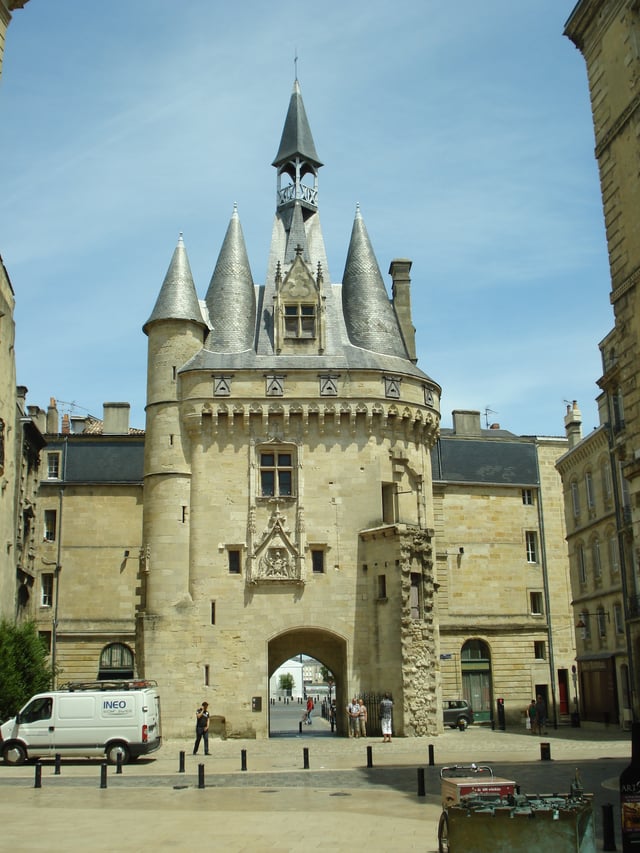
Porte Cailhau
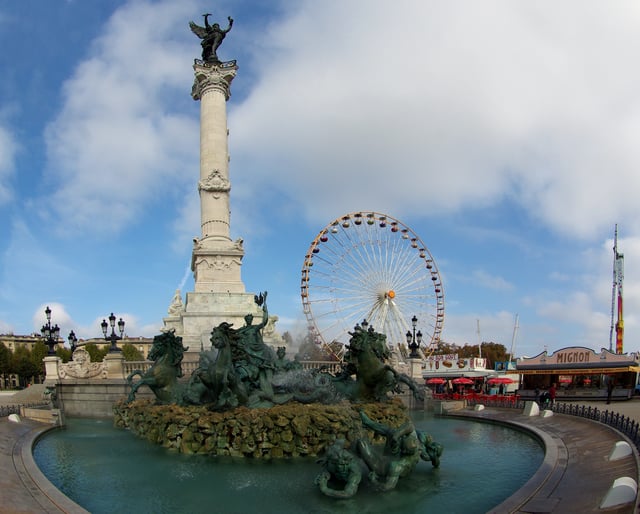
Column of the Girondins on the Esplanade des Quinconces
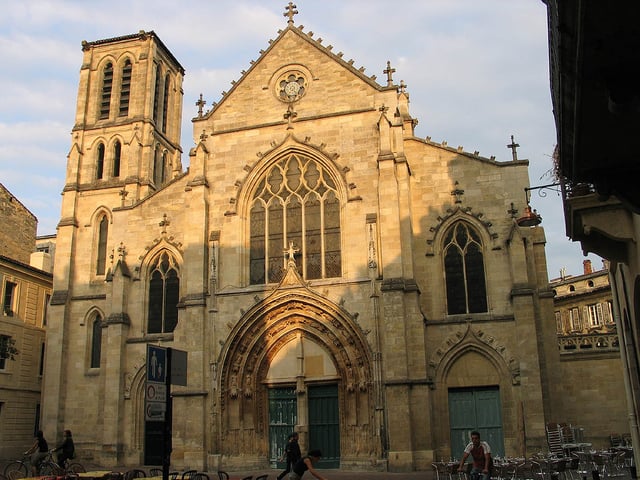
The church of St Pierre
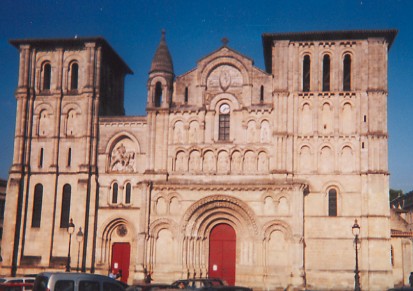
Façade of the Church of the Holy Cross
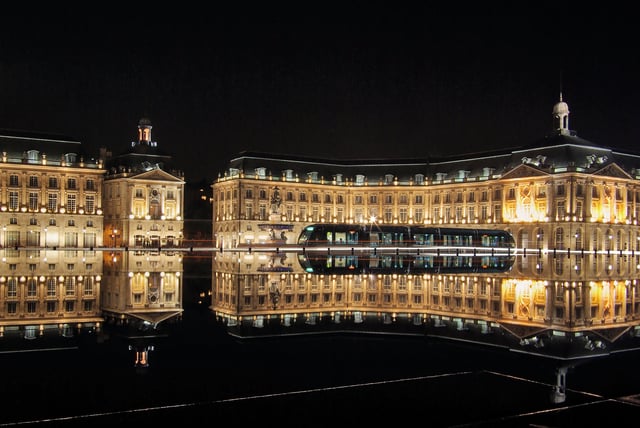
Place de la Bourse at night with the Miroir d'eau and tram
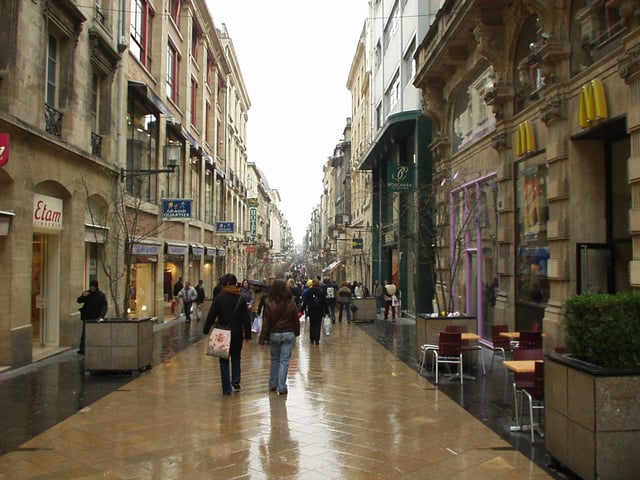
Rue Sainte-Catherine
Bordeaux is classified "City of Art and History". The city is home to 362 monuments historiques (only Paris has more in France) with some buildings dating back to Roman times. Bordeaux has been inscribed on UNESCO World Heritage List as "an outstanding urban and architectural ensemble".
Bordeaux is home to one of Europe's biggest 18th-century architectural urban areas, making it a sought-after destination for tourists and cinema production crews. It stands out as one of the first French cities, after Nancy, to have entered an era of urbanism and metropolitan big scale projects, with the team Gabriel father and son, architects for King Louis XV, under the supervision of two intendants (Governors), first Nicolas-François Dupré de Saint-Maur then the Marquis de Tourny.
Buildings
Main sights include:
Place des Quinconces, the largest square in France.
Monument aux Girondins
Grand Théâtre, a large neoclassical theater built in the 18th century.
Allées de Tourny
Cours de l'Intendance
Place du Chapelet
Place de la Bourse(1730–1775), designed by the Royal architect Jacques Ange Gabriel as landscape for an equestrian statue of Louis XV.
Place du Parlement
Place Saint-Pierre
Pont de pierre
Saint-André Cathedral, consecrated by Pope Urban II in 1096. Of the original Romanesque edifice only a wall in the nave remains. The Royal Gate is from the early 13th century, while the rest of the construction is mostly from the 14th and 15th centuries.
Tour Pey-Berland (1440–1450), a massive, quadrangular Gothic tower annexed to the cathedral.
Église Sainte-Croix (Church of the Holy Cross). It lies on the site of a 7th-century abbey destroyed by the Saracens. Rebuilt under the Carolingians, it was again destroyed by the Normans in 845 and 864. It is annexed to a Benedictine abbey founded in the 7th century, and was built in the late 11th and early 12th centuries. The façade is in Romanesque style
The Gothic Basilica of Saint Michael, constructed between the end of the 14th century and the 16th century.
Basilica of Saint-Seurin, the most ancient church in Bordeaux. It was built in the early 6th century on the site of a palaeochristian necropolis. It has an 11th-century portico, while the apse and transept are from the following century. The 13th-century nave has chapels from the 11th and the 14th centuries. The ancient crypt houses sepulchres of the Merovingian family.
Église Saint-Pierre, gothic church
Église Saint-Éloi, gothic church
Église Saint-Bruno, baroque church decorated with frescoes
Église Notre-Dame, baroque church
Église Saint-Paul-Saint-François-Xavier, baroque church
Palais Rohan (Exterior:[25])
Palais Gallien, the remains of a late 2nd-century Roman amphitheatre
Porte Cailhau, a medieval gate of the old city walls.
La Grosse Cloche (15th century), the second remaining gate of the Medieval walls. It was the belfry of the old Town Hall. It consists of two 40-metre-high (131-foot) circular towers and a central bell tower housing a bell weighing 7,800 kilograms (17,200 lb). The watch is from 1759.
Rue Sainte-Catherine, the longest pedestrian street of France
The BETASOM submarine base
Saint-André Cathedral, Saint-Michel Basilica and Saint-Seurin Basilica are part of the World Heritage Sites of the Routes of Santiago de Compostela in France.
Contemporary architecture
Fire Station, la Benauge, Claude Ferret/Adrien Courtois/Yves Salier, 1951–1954
Court of first instance, Richard Rogers, 1998
CTBA, wood and furniture research center, A. Loisier, 1998
Hangar 14 on the Quai des Chartrons, 1999
The Management Science faculty on the Bastide, Anne Lacaton/Jean-Philippe Vassal, 2006
The Jardin botanique de la Bastide, Catherine Mosbach/Françoise Hélène Jourda/Pascal Convert, 2007
The Nuyens School complex on the Bastide, Yves Ballot/Nathalie Franck, 2007
Seeko'o Hotel on the Quai des Chartrons, King Kong architects, 2007
Museums
Musée des Beaux Arts (Fine arts museum), one of the finest painting galleries in France with paintings by painter such as Tiziano, Veronese, Rubens, Van Dyck, Frans Hals, Claude, Chardin, Delacroix, Renoir, Seurat, Matisse and Picasso.
Musée d'Aquitaine (archeological and history museum)
Musée du Vin et du Négoce (museum of the wine trade)
Musée des Arts Décoratifs (museum of decorative arts)
Musée d'Histoire Naturelle (natural history museum)
CAPC musée d'art contemporain de Bordeaux (contemporary art museum)
Musée national des douanes
Vinorama
Musée Goupil
Casa de Goya
Cap Sciences
Centre Jean Moulin
Parks and gardens
Jardin botanique de Bordeaux
Jardin botanique de la Bastide
La Maison des Chameaux (Camel Park)
"Le Jardin Public" is a park in the heart of the city.
Pont Jacques Chaban-Delmas
Europe's longest-span vertical-lift bridge, the Pont Jacques Chaban-Delmas, was opened in 2013 in Bordeaux, spanning the River Garonne. The central lift span is 117-metre-long (384-foot) and can be lifted vertically up to 53 metres (174 feet) to let tall ships pass underneath. The €160 million bridge was inaugurated by President François Hollande and Mayor Alain Juppé on 16 March 2013. The bridge was named after the late Jacques Chaban-Delmas, who was a former Prime Minister and Mayor of Bordeaux.
Shopping
Bordeaux has many shopping options. In the heart of Bordeaux is Rue Sainte-Catherine. This pedestrian-only shopping street has 1.2 kilometers (0.75 mi) of shops, restaurants and cafés; it is also one of the longest shopping streets in Europe. Rue Sainte-Catherine starts at Place de la Victoire and ends at Place de la Comédie by the Grand Théâtre. The shops become progressively more upmarket as one moves towards Place de la Comédie and the nearby Cours de l'Intendance is where one finds the more exclusive shops and boutiques.
Culture
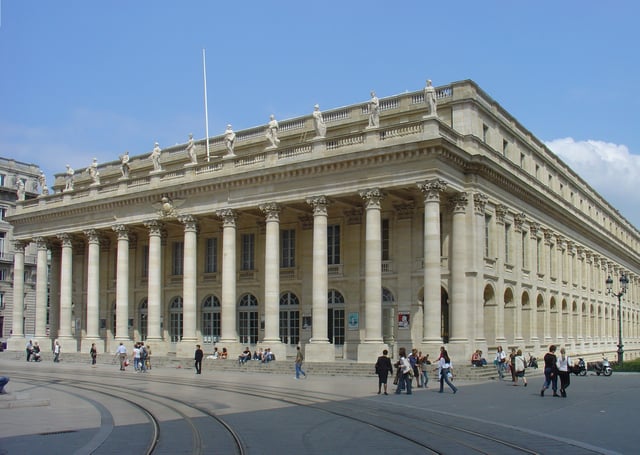
Grand Théâtre
Bordeaux is also the first city in France to have created, in the 1980s, an architecture exhibition and research centre, Arc en rêve. Bordeaux offers a large number of cinemas, theatres, and is the home of the Opéra national de Bordeaux. There are many music venues of varying capacity. The city also offers several festivals throughout the year. Bordeaux is the first urban ensemble on such a large and elaborate scale to be nominated for inclusion in the UNESCO World Heritage List. The boundaries of the core zone submitted for inscription are the Garonne and, from North to South, the outer Boulevards.[26]
Transport
Road
Bordeaux is an important road and motorway junction. The city is connected to Paris by the A10 motorway, with Lyon by the A89, with Toulouse by the A62, and with Spain by the A63. There is a 45 km (28 mi) ring road called the "Rocade" which is often very busy. Another ring road is under consideration.
Bordeaux has five road bridges that cross the Garonne, the Pont de pierre built in the 1820s and three modern bridges built after 1960: the Pont Saint Jean, just south of the Pont de pierre (both located downtown), the Pont d'Aquitaine, a suspended bridge downstream from downtown, and the Pont François Mitterrand, located upstream of downtown. These two bridges are part of the ring road around Bordeaux. A fifth bridge, the Pont Jacques-Chaban-Delmas, was constructed in 2009–2012 and opened to traffic in March 2013. Located halfway between the Pont de pierre and the Pont d'Aquitaine and serving downtown rather than highway traffic, it is a vertical-lift bridge with a height comparable to the Pont de pierre in closed position, and to the Pont d'Aquitaine in open position. All five road bridges, including the two highway bridges, are open to cyclists and pedestrians as well. Another bridge, the Pont Jean-Jacques Bosc, is to be built in 2018.[27]
Lacking any steep hills, Bordeaux is relatively friendly to cyclists. Cycle paths (separate from the roadways) exist on the highway bridges, along the riverfront, on the university campuses, and incidentally elsewhere in the city. Cycle lanes and bus lanes that explicitly allow cyclists exist on many of the city's boulevards. A paid bicycle-sharing system with automated stations has been established in 2010.
Rail
The main railway station, Gare de Bordeaux Saint-Jean, near the center of the city, has 12 million passengers a year. It is served by the French national (SNCF) railway's high speed train, the TGV, that gets to Paris in two hours, with connections to major European centers such as Lille, Brussels, Amsterdam, Cologne, Geneva and London. The TGV also serves Toulouse and Irun (Spain) from Bordeaux. A regular train service is provided to Nantes, Nice, Marseille and Lyon. The Gare Saint-Jean is the major hub for regional trains (TER) operated by the SNCF to Arcachon, Limoges, Agen, Périgueux, Langon, Pau, Le Médoc, Angoulême and Bayonne.
Historically the train line used to terminate at a station on the right bank of the river Garonne near the Pont de Pierre, and passengers crossed the bridge to get into the city. Subsequently, a double-track steel railway bridge was constructed in the 1850s, by Gustave Eiffel, to bring trains across the river direct into Gare de Bordeaux Saint-Jean. The old station was later converted and in 2010 comprised a cinema and restaurants.
The two-track Eiffel bridge with a speed limit of 30 km/h (19 mph) became a bottleneck and a new bridge was built, opening in 2009. The new bridge has four tracks and allows trains to pass at 60 km/h (37 mph).[28] During the planning there was much lobbying by the Eiffel family and other supporters to preserve the old bridge as a footbridge across the Garonne, with possibly a museum to document the history of the bridge and Gustave Eiffel's contribution. The decision was taken to save the bridge, but by early 2010 no plans had been announced as to its future use. The bridge remains intact, but unused and without any means of access.
Since July 2017, the LGV Sud Europe Atlantique is fully operational and makes Bordeaux city 2h04 from Paris.
Air
Bordeaux is served by Bordeaux–Mérignac Airport, located 8 km (5.0 mi) from the city center in the suburban city of Mérignac.
Trams, buses and boats

Tramway in Bordeaux
Bordeaux has an important public transport system called Transports Bordeaux Métropole (TBM). This company is run by the Keolis group. The network consists of:
3 tram lines (A, B and C)
75 bus routes, all connected to the tramway network (from 1 to 96)
13 night bus routes (from 1 to 16)
An electric bus shuttle in the city center
A boat shuttle on the Garonne river
This network is operated from 5 am to 2 am.
There had been several plans for a subway network to be set up, but they stalled for both geological and financial reasons. Work on the Tramway de Bordeaux system was started in the autumn of 2000, and services started in December 2003 connecting Bordeaux with its suburban areas. The tram system uses ground-level power supply technology (APS), a new cable-free technology developed by French company Alstom and designed to preserve the aesthetic environment by eliminating overhead cables in the historic city. Conventional overhead cables are used outside the city. The system was controversial for its considerable cost of installation, maintenance and also for the numerous initial technical problems that paralysed the network. Many streets and squares along the tramway route became pedestrian areas, with limited access for cars.
The planned Bordeaux tramway system is to link with the airport to the city centre towards the end of 2019.[29]
Taxis
There are more than 400 taxicabs in Bordeaux.
Bordeaux Public Transportation Statistics
The average amount of time people spend commuting with public transit in Bordeaux, for example to and from work, on a weekday is 51 min. 12.% of public transit riders, ride for more than 2 hours every day. The average amount of time people wait at a stop or station for public transit is 13 min, while 15.5% of riders wait for over 20 minutes on average every day. The average distance people usually ride in a single trip with public transit is 7 km (4.3 mi), while 8% travel for over 12 km (7.5 mi) in a single direction.[30]
Sport

Entrance to the Stade Chaban-Delmas
The 41,458-capacity Nouveau Stade de Bordeaux is the largest stadium in Bordeaux. The stadium was opened in 2015 and replaced the Stade Chaban-Delmas, which was a venue for the FIFA World Cup in 1938 and 1998, as well as the 2007 Rugby World Cup. In the 1938 FIFA World Cup, it hosted a violent quarter-final known as the Battle of Bordeaux. The ground was formerly known as the Stade du Parc Lescure until 2001, when it was renamed in honour of the city's long-time mayor, Jacques Chaban-Delmas.
There are two major sport teams in Bordeaux, Girondins de Bordeaux is the football team, playing in Ligue 1 in the French football championship. Union Bordeaux Bègles is a rugby team in the Top 14 in the Ligue Nationale de Rugby. Skateboarding, rollerblading, and BMX biking are activities enjoyed by many young inhabitants of the city. Bordeaux is home to a beautiful quay which runs along the Garonne river. On the quay there is a skate-park divided into three sections. One section is for Vert tricks, one for street style tricks, and one for little action sports athletes with easier features and softer materials. The skate-park is very well maintained by the municipality.
Bordeaux is also the home to one of the strongest cricket teams in France and are champions of the South West League.
There is a 250 m (820 ft) wooden velodrome, Vélodrome du Lac, in Bordeaux which hosts international cycling competition in the form of UCI Track Cycling World Cup events.
The 2015 Trophee Eric Bompard was in Bordeaux. But the Free Skate was cancelled in all of the divisions due to the Paris bombing(s) and aftermath. The Short Program occurred hours before the bombing. French skaters Chafik Besseghier (68.36) in 10th place, Romain Ponsart (62.86) in 11th. Mae-Berenice-Meite (46.82) in 11th and Laurine Lecavelier (46.53) in 12th. Vanessa James/Morgan Cipres (65.75) in 2nd.
Between 1951 and 1955, an annual Formula 1 motor race was held on a 2.5-kilometre circuit which looped around the Esplanade des Quinconces and along the waterfront, attracting drivers such as Juan Manuel Fangio, Stirling Moss, Jean Behra and Maurice Trintignant.[31]
Notable people
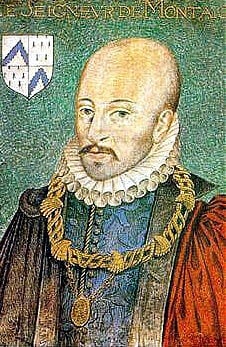
Michel de Montaigne
Jean Alaux (1786–1864), painter
Bertrand Andrieu (1761–1822), engraver
Jean Anouilh (1910–1987), dramatist
Yvonne Arnaud (1892–1958), pianist, singer and actress
Decimus Magnus Ausonius (c. 310–395), Roman poet and rhetorician
Floyd Ayité, (born 1988), Togolese footballer
Jonathan Ayité, (born 1985), Togolese footballer
Christine Barbe, winemaker
Gérard Bayo (born 1936), writer and poet,
François Bigot (1703–1778), last "Intendant" of New France
Grégory Bourdy, (born 1982), golfer
Samuel Boutal, (born 1969), footballer
Edmond de Caillou (died c. February 1316) Gascon knight fighting in Scotland
Gérald Caussé, Presiding Bishop of The Church of Jesus Christ of Latter Day Saints
René Clément (1913–1996), actor, director, writer
Jean-René Cruchet (1875–1959), pathologist
Damia (1899–1978), singer and actress
Étienne Noël Damilaville (1723–1768), encyclopédiste
Lili Damita (1901–1994), actress
Frédéric Daquin, (born 1978), footballer
Danielle Darrieux (born 1917), actress
Bernard Delvaille (1931–2006), poet, essayist
David Diop, (1927–1960), poet
Jean-Francois Domergue, footballer
Jacques Ellul (1912–1994), sociologist, theologian, Christian anarchist
Marie Fel (1713–1794), opera singer
Jean-Luc Fournet (1965), papyrologist
Pierre-Jean Garat (1762–1823), singer
Armand Gensonné (1758–1793), politician
Stephen Girard (1750–1831), merchant, banker, and Philadelphia philanthropist
Jérôme Gnako, (born 1968), footballer
Eugène Goossens (1867–1958), conductor, violinist
Anna Hamilton (1864-1935), doctor, superintendent of the Protestant Hospital at Bordeaux (1901-1934)
Léopold Lafleurance (1865–1953), flautist
Joseph Henri Joachim Lainé (1767–1835), statesman
Lucenzo (born 1983), singer
Jean-Jacques Magendie (1766–1835), officer
François Magendie (1783–1855), physiologist
Bruno Marie-Rose, (born 1965), athlete (sprinter)
François Mauriac (1885–1970), writer, Nobel laureate 1952
Édouard Molinaro (1928–2013), film director, screenwriter
Michel de Montaigne (1533–1592), essayist
Olivier Mony (1966–), writer and literary critic
Étienne Marie Antoine Champion de Nansouty (1768–1815), general
Pierre Palmade (born 1968), actor and comedian
St. Paulinus of Nola (354–431), educator, religious figure
Émile Péreire (1800–1875), banker and industrialist
Albert Pitres (1848–1928), neurologist
Georges Antoine Pons Rayet (1839–1906), astronomer, discoverer of the Wolf-Rayet stars, & founder of the Bordeaux Observatory
Odilon Redon, (1840–1916), painter
Richard II of England (1367–1400), king
Pierre Rode (1774–1830), violinist
Olinde Rodrigues (1795–1851), mathematician, banker and social reformer
Marie-Sabine Roger (born 1957), writer
Bernard Sarrette (1765–1858), conductor and music pedagogue
Jean-Jacques Sempé (born 1932), cartoonist
Florent Serra, (born 1981), tennis player
Philippe Sollers, (born 1936), writer
Wilfried Tekovi, (born 1989), Togolese footballer
Kap Bambino, group
Arnaud Binard, (born 1971), actor and producer
Elie Okobo, basketball player
International relationship
Twin towns and sister cities
[[INLINE_IMAGE|//upload.wikimedia.org/wikipedia/commons/thumb/d/d4/Flag_of_Israel.svg/21px-Flag_of_Israel.svg.png|//upload.wikimedia.org/wikipedia/commons/thumb/d/d4/Flag_of_Israel.svg/32px-Flag_of_Israel.svg.png 1.5x, //upload.wikimedia.org/wikipedia/commons/thumb/d/d4/Flag_of_Israel.svg/41px-Flag_of_Israel.svg.png 2x|Israel|h15|w21|thumbborder flagicon-img flagicon-img]] Ashdod, Israel, since 1984[32][33]
[[INLINE_IMAGE|//upload.wikimedia.org/wikipedia/en/thumb/9/9a/Flag_of_Spain.svg/23px-Flag_of_Spain.svg.png|//upload.wikimedia.org/wikipedia/en/thumb/9/9a/Flag_of_Spain.svg/35px-Flag_of_Spain.svg.png 1.5x, //upload.wikimedia.org/wikipedia/en/thumb/9/9a/Flag_of_Spain.svg/45px-Flag_of_Spain.svg.png 2x|Spain|h15|w23|thumbborder flagicon-img flagicon-img]] Bilbao, Spain[32][33]
[[INLINE_IMAGE|//upload.wikimedia.org/wikipedia/commons/thumb/d/dd/Flag_of_Azerbaijan.svg/23px-Flag_of_Azerbaijan.svg.png|//upload.wikimedia.org/wikipedia/commons/thumb/d/dd/Flag_of_Azerbaijan.svg/35px-Flag_of_Azerbaijan.svg.png 1.5x, //upload.wikimedia.org/wikipedia/commons/thumb/d/dd/Flag_of_Azerbaijan.svg/46px-Flag_of_Azerbaijan.svg.png 2x|Azerbaijan|h12|w23|thumbborder flagicon-img flagicon-img]] Baku, Azerbaijan, since 1985[33][35]
[[INLINE_IMAGE|//upload.wikimedia.org/wikipedia/en/thumb/a/ae/Flag_of_the_United_Kingdom.svg/23px-Flag_of_the_United_Kingdom.svg.png|//upload.wikimedia.org/wikipedia/en/thumb/a/ae/Flag_of_the_United_Kingdom.svg/35px-Flag_of_the_United_Kingdom.svg.png 1.5x, //upload.wikimedia.org/wikipedia/en/thumb/a/ae/Flag_of_the_United_Kingdom.svg/46px-Flag_of_the_United_Kingdom.svg.png 2x|United Kingdom|h12|w23|thumbborder flagicon-img flagicon-img]] Bristol, United Kingdom, since 1947[32][33][36][37]
[[INLINE_IMAGE|//upload.wikimedia.org/wikipedia/commons/thumb/2/2c/Flag_of_Morocco.svg/23px-Flag_of_Morocco.svg.png|//upload.wikimedia.org/wikipedia/commons/thumb/2/2c/Flag_of_Morocco.svg/35px-Flag_of_Morocco.svg.png 1.5x, //upload.wikimedia.org/wikipedia/commons/thumb/2/2c/Flag_of_Morocco.svg/45px-Flag_of_Morocco.svg.png 2x|Morocco|h15|w23|thumbborder flagicon-img flagicon-img]] Casablanca, Morocco, since 1988[32][33]
[[INLINE_IMAGE|//upload.wikimedia.org/wikipedia/en/thumb/9/9e/Flag_of_Japan.svg/23px-Flag_of_Japan.svg.png|//upload.wikimedia.org/wikipedia/en/thumb/9/9e/Flag_of_Japan.svg/35px-Flag_of_Japan.svg.png 1.5x, //upload.wikimedia.org/wikipedia/en/thumb/9/9e/Flag_of_Japan.svg/45px-Flag_of_Japan.svg.png 2x|Japan|h15|w23|thumbborder flagicon-img flagicon-img]] Fukuoka, Japan, since 1982[32][33]
[[INLINE_IMAGE|//upload.wikimedia.org/wikipedia/commons/thumb/c/cf/Flag_of_Peru.svg/23px-Flag_of_Peru.svg.png|//upload.wikimedia.org/wikipedia/commons/thumb/c/cf/Flag_of_Peru.svg/35px-Flag_of_Peru.svg.png 1.5x, //upload.wikimedia.org/wikipedia/commons/thumb/c/cf/Flag_of_Peru.svg/45px-Flag_of_Peru.svg.png 2x|Peru|h15|w23|thumbborder flagicon-img flagicon-img]] Lima, Peru, since 1957[32][33]
[[INLINE_IMAGE|//upload.wikimedia.org/wikipedia/en/thumb/a/a4/Flag_of_the_United_States.svg/23px-Flag_of_the_United_States.svg.png|//upload.wikimedia.org/wikipedia/en/thumb/a/a4/Flag_of_the_United_States.svg/35px-Flag_of_the_United_States.svg.png 1.5x, //upload.wikimedia.org/wikipedia/en/thumb/a/a4/Flag_of_the_United_States.svg/46px-Flag_of_the_United_States.svg.png 2x|United States|h12|w23|thumbborder flagicon-img flagicon-img]] Los Angeles, United States, since 1968[32][33][38]
[[INLINE_IMAGE|//upload.wikimedia.org/wikipedia/en/thumb/9/9a/Flag_of_Spain.svg/23px-Flag_of_Spain.svg.png|//upload.wikimedia.org/wikipedia/en/thumb/9/9a/Flag_of_Spain.svg/35px-Flag_of_Spain.svg.png 1.5x, //upload.wikimedia.org/wikipedia/en/thumb/9/9a/Flag_of_Spain.svg/45px-Flag_of_Spain.svg.png 2x|Spain|h15|w23|thumbborder flagicon-img flagicon-img]] Madrid, Spain, since 1984[32][33]
[[INLINE_IMAGE|//upload.wikimedia.org/wikipedia/en/thumb/b/ba/Flag_of_Germany.svg/23px-Flag_of_Germany.svg.png|//upload.wikimedia.org/wikipedia/en/thumb/b/ba/Flag_of_Germany.svg/35px-Flag_of_Germany.svg.png 1.5x, //upload.wikimedia.org/wikipedia/en/thumb/b/ba/Flag_of_Germany.svg/46px-Flag_of_Germany.svg.png 2x|Germany|h14|w23|thumbborder flagicon-img flagicon-img]] Munich, Germany, since 1964[32][33][39]
[[INLINE_IMAGE|//upload.wikimedia.org/wikipedia/commons/thumb/7/77/Flag_of_Algeria.svg/23px-Flag_of_Algeria.svg.png|//upload.wikimedia.org/wikipedia/commons/thumb/7/77/Flag_of_Algeria.svg/35px-Flag_of_Algeria.svg.png 1.5x, //upload.wikimedia.org/wikipedia/commons/thumb/7/77/Flag_of_Algeria.svg/45px-Flag_of_Algeria.svg.png 2x|Algeria|h15|w23|thumbborder flagicon-img flagicon-img]] Oran, Algeria, since 2003[32][33]
[[INLINE_IMAGE|//upload.wikimedia.org/wikipedia/commons/thumb/5/5c/Flag_of_Portugal.svg/23px-Flag_of_Portugal.svg.png|//upload.wikimedia.org/wikipedia/commons/thumb/5/5c/Flag_of_Portugal.svg/35px-Flag_of_Portugal.svg.png 1.5x, //upload.wikimedia.org/wikipedia/commons/thumb/5/5c/Flag_of_Portugal.svg/45px-Flag_of_Portugal.svg.png 2x|Portugal|h15|w23|thumbborder flagicon-img flagicon-img]] Porto, Portugal, since 1978[32][33][40]
[[INLINE_IMAGE|//upload.wikimedia.org/wikipedia/commons/thumb/d/d9/Flag_of_Canada_%28Pantone%29.svg/23px-Flag_of_Canada_%28Pantone%29.svg.png|//upload.wikimedia.org/wikipedia/commons/thumb/d/d9/Flag_of_Canada_%28Pantone%29.svg/35px-Flag_of_Canada_%28Pantone%29.svg.png 1.5x, //upload.wikimedia.org/wikipedia/commons/thumb/d/d9/Flag_of_Canada_%28Pantone%29.svg/46px-Flag_of_Canada_%28Pantone%29.svg.png 2x|Canada|h12|w23|thumbborder flagicon-img flagicon-img]] Quebec City, Canada, since 1962[32][33]
[[INLINE_IMAGE|//upload.wikimedia.org/wikipedia/commons/thumb/8/84/Flag_of_Latvia.svg/23px-Flag_of_Latvia.svg.png|//upload.wikimedia.org/wikipedia/commons/thumb/8/84/Flag_of_Latvia.svg/35px-Flag_of_Latvia.svg.png 1.5x, //upload.wikimedia.org/wikipedia/commons/thumb/8/84/Flag_of_Latvia.svg/46px-Flag_of_Latvia.svg.png 2x|Latvia|h12|w23|thumbborder flagicon-img flagicon-img]] Riga, Latvia[32][33][41]
[[INLINE_IMAGE|//upload.wikimedia.org/wikipedia/en/thumb/f/f3/Flag_of_Russia.svg/23px-Flag_of_Russia.svg.png|//upload.wikimedia.org/wikipedia/en/thumb/f/f3/Flag_of_Russia.svg/35px-Flag_of_Russia.svg.png 1.5x, //upload.wikimedia.org/wikipedia/en/thumb/f/f3/Flag_of_Russia.svg/45px-Flag_of_Russia.svg.png 2x|Russia|h15|w23|thumbborder flagicon-img flagicon-img]] Saint Petersburg, Russia, since 1993[32][33][42]
[[INLINE_IMAGE|//upload.wikimedia.org/wikipedia/commons/thumb/f/fa/Flag_of_the_People%27s_Republic_of_China.svg/23px-Flag_of_the_People%27s_Republic_of_China.svg.png|//upload.wikimedia.org/wikipedia/commons/thumb/f/fa/Flag_of_the_People%27s_Republic_of_China.svg/35px-Flag_of_the_People%27s_Republic_of_China.svg.png 1.5x, //upload.wikimedia.org/wikipedia/commons/thumb/f/fa/Flag_of_the_People%27s_Republic_of_China.svg/45px-Flag_of_the_People%27s_Republic_of_China.svg.png 2x|China|h15|w23|thumbborder flagicon-img flagicon-img]] Wuhan, China, since 1998[32][33]
[[INLINE_IMAGE|//upload.wikimedia.org/wikipedia/commons/thumb/5/59/Flag_of_Lebanon.svg/23px-Flag_of_Lebanon.svg.png|//upload.wikimedia.org/wikipedia/commons/thumb/5/59/Flag_of_Lebanon.svg/35px-Flag_of_Lebanon.svg.png 1.5x, //upload.wikimedia.org/wikipedia/commons/thumb/5/59/Flag_of_Lebanon.svg/45px-Flag_of_Lebanon.svg.png 2x|Lebanon|h15|w23|thumbborder flagicon-img flagicon-img]] Zahlé, Lebanon, since 2006[33]
Partnerships
[[INLINE_IMAGE|//upload.wikimedia.org/wikipedia/en/thumb/1/12/Flag_of_Poland.svg/23px-Flag_of_Poland.svg.png|//upload.wikimedia.org/wikipedia/en/thumb/1/12/Flag_of_Poland.svg/35px-Flag_of_Poland.svg.png 1.5x, //upload.wikimedia.org/wikipedia/en/thumb/1/12/Flag_of_Poland.svg/46px-Flag_of_Poland.svg.png 2x|Poland|h14|w23|thumbborder flagicon-img flagicon-img]] Kraków, Poland, since 1993[32][33][43]
[[INLINE_IMAGE|//upload.wikimedia.org/wikipedia/commons/thumb/b/b4/Flag_of_Turkey.svg/23px-Flag_of_Turkey.svg.png|//upload.wikimedia.org/wikipedia/commons/thumb/b/b4/Flag_of_Turkey.svg/35px-Flag_of_Turkey.svg.png 1.5x, //upload.wikimedia.org/wikipedia/commons/thumb/b/b4/Flag_of_Turkey.svg/45px-Flag_of_Turkey.svg.png 2x|Turkey|h15|w23|thumbborder flagicon-img flagicon-img]] Samsun, Turkey, since 2010[33][44]
See also
Bordeaux wine regions
Bordeaux–Paris, a former professional road bicycle racing
The Burdigalian Age of the Miocene Epoch is named for Bordeaux
Canelé, a local pastry
Communes of the Gironde department
Dogue de Bordeaux, a breed of dog originally bred for dog fighting
French wine
List of mayors of Bordeaux
Operation Frankton, a British Combined Operations raid on shipping in the harbour at Bordeaux, in December 1942, during World War II
Roman Catholic Archdiocese of Bordeaux
Girondins
Atlantic history
Triangular trade
History of slavery





